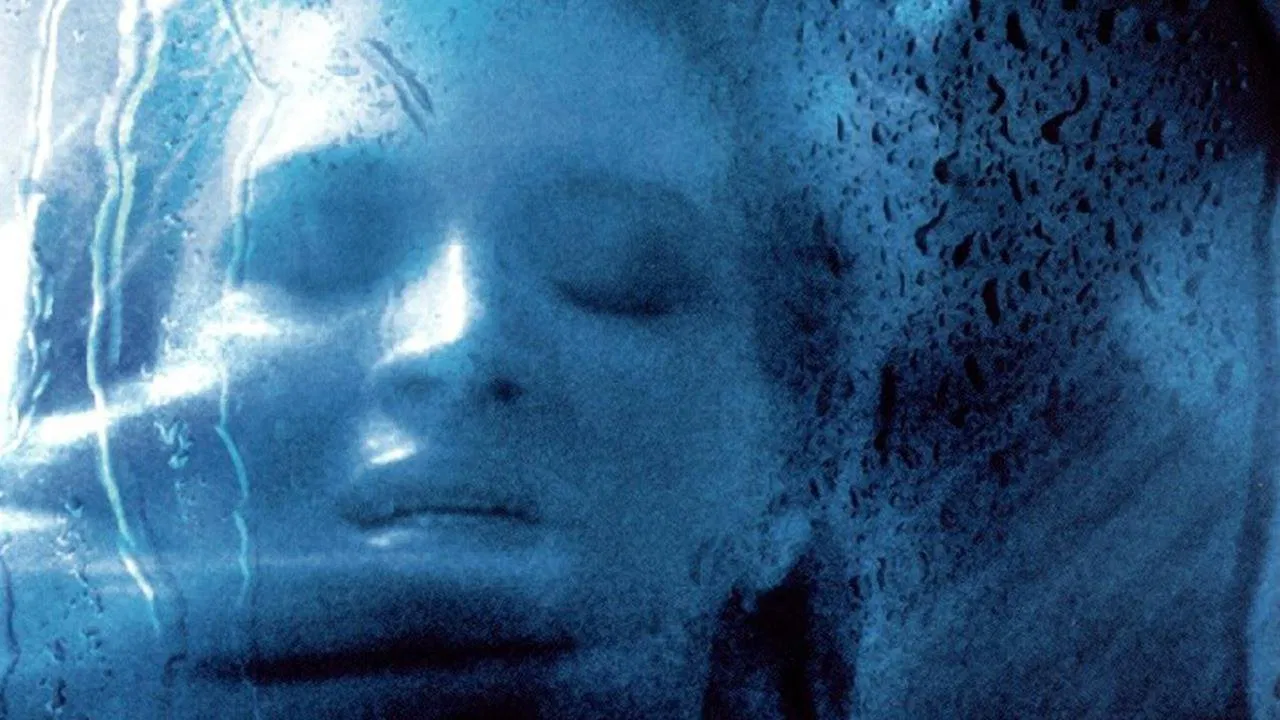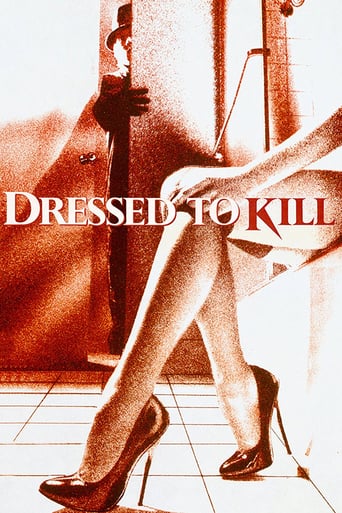

Brain DePalma channels Alfred Hitchcock and delivers a thriller about sexual repression and murder.Kate Miller (Angie Dickinson) is a sexually frustrated housewife who is in therapy with New York City psychiatrist Dr. Robert Elliott (Michael Caine). During an appointment, Kate attempts to seduce him, but Elliott rejects her advances.The rejection sends Kate into a tailspin in which puts the viewer on journey of darkest part of the human experience. Not a great film but worth watching but its RATED R for a reason
... View MoreIf I were dissatisfied with my marriage and Michael Caine was my therapist, I'd probably have a crush on him. Apparently, Angie Dickinson agrees with me, for in Dressed to Kill, she hits on him during a session. She's married to Keith Gordon, and dislikes many aspects of their marriage, including their bedroom activities. When Michael rebuffs her advances, she looks elsewhere.Dressed to Kill, while completely earning its R rating—it was originally rated X before certain elements were cut—is a very fun thriller. Depending on how comfortable you are in your relationship, this might be a good pick to watch during your steamy movie night. Brian De Palma's script will keep you guessing from start to finish, and you'll be on the edge of your seat once the serial killer makes an appearance and bodies start dropping. It can be pretty scary at times, but if you like this type of movie, it's a really great one. I'm a bit of a lightweight when it comes to scary movies, but I'm also a huge Michael Caine fan, so I ended up liking it.Kiddy Warning: Obviously, you have control over your own children. However, due to graphic nudity, sex scenes, and violence, I wouldn't let my kids watch it.
... View MoreBrian DePalma was born four days after Dario Argento on 11th September 1940, but they could have been separated at birth; and for those familiar with DePalma's work that would make you think of 'Sisters' (1973), a film that has a lot more to do with Hitchcock (an obvious influence on both their work), than with Argento in particular. The similarities come from an idiosyncratic assimilation of Hitchcock rather than from seeing and copying each other's work. Both directors like the 'Master' are relentless fetishists. I do find it hard to imagine DePalma's cinema without Argento's; 'Body Double' (1984), and 'Raising Cain' (1992) have grown out of 'Tenebre' (1982). Argento is a modernist rather than the more fashionable postmodern, and like Ingmar Bergman or John Ford he falls in and out of fashion with critics and the public. He has influenced his 'apprentices' Luigi Cozzi, Michele Soavi and Lamberto Bava; but he has also touched more celebrated filmmakers like John Carpenter (think 1978's 'Halloween'), Wes Craven, Takeshi Miike (Argento is 'big in Japan'), John Woo, David Fincher, and Spanish auteur Pedro Almodóvar. But with DePalma the influence runs a lot deeper even the word Doppelganger could be considered, but I'm not sure who you would point the finger at as being the unfortunate one. For all their similarities though, you can compare DePalma to Godard (most obviously with 'Greetings' (1968), and 'Hi, Mom!' (1970), and Godard has written of his admiration for DePalma's 'The Fury' 1978), whereas you can't easily compare Argento to Godard. It is helpful to think of DePalma as a jazz musician riffing on themes, his favourite pieces to riff on being 'Vertigo' and 'Psycho'. Familiar with 'Giallo,' he rarely cites them as influences (he claims to despise Argento's films). DePalma's dreamlike tangle of memory and desire owes less to Hitchcock than to the psychological 'Giallo' of Argento, and the baroque set pieces and sociopathic gender games of 'Dressed to Kill' and 'Body Double' scream Argento, but it's 'Raising Cain's' finale that completes the deal. A woman bends over to pick up her child, revealing the killer standing directly behind her, a scene straight out of 'Tenebrae'.'Dressed to Kill' could easily be described as a 'Giallo,' as DePalma pushes the boundaries of what is acceptable and in good taste (with mainstream cinema). 'Dressed To Kill' was a film that was released at the right time; post- Stonewall, post-feminist, post-disco, post-Son of Sam, pre-AIDS. However as controversial as DePalma wanted to be, 'Dressed to Kill' only has the whiff of cheap perfume compared to the pungent odor of its contemporaries of the grindhouse; William Lustig's 'Maniac' (1980), and Abel Ferrara's 'Ms. 45' (1981). Even another film from the big end of town, William Friedkin's 'Cruising' (1980), which DePalma had for a time been attached to was more controversial and sleazy; yet 'Dressed To Kill' shocked because more people saw it. DePalma uses paperback pulp psychology (pure 'Giallo'), to demonstrate that filmmaking is an inherently 'visual' storytelling medium. It is clear he is always more at home with scenes free of dialogue; the characters speak in pure soap opera exposition.The opening 'shower scene' establishes the theme; Kate is in the shower masturbating whilst watching probably her husband shaving; it's DePalma's 'thing', linking sexual stimulation to voyeurism. Hands clutch her from behind and she screams. Looking, pleasuring, violating. The sound design connects the next scene, where Kate is in bed moaning with 'ersatz' pleasure; talk radio dominates the soundtrack rather than a lush romantic musical score, and a high-angle shot fixes on the faceless husband and Kate's unfulfilled expression. Later, when she attempts to 'come on' to her shrink, the Doctor advises her to confront her husband about her anxieties. Before doing this, Kate visits the Metropolitan Museum of Art with nothing more on her mind than a shopping list (an inspired touch), and links up with a mysterious stranger. Following a hot and sweaty seduction in the back seat of a cab, she goes back to his apartment for a game of post-office. Immediately after, she is confronted by a mysterious blonde with a 'Giallo' like shiny straight razor. As Hitchcock had done audaciously in 'Psycho', DePalma does the unthinkable in the first act killing the woman we had assumed was the heroine. It's a dangerous trick, as the audience now has to reach out to new characters, Liz and Peter as the film starts again. Like Marcus in Argento's 'Deep Red', Liz (a prostitute, an outsider) must do the detective work.As with Argento, DePalma likes set-pieces featuring long takes with a mobile camera, and for DePalma in 'Dressed To Kill' it's the Metropolitan Museum of Art sequence. DePalma's obsessively moody overwrought sequence is a slice of the purest melodramatic overkill. DePalma's timing of Kate's impulses with the unreal ambiance and heightened emotion is overplayed to absurdity. Technically DePalma is as accomplished as ever.The Italian Argento, coming from a Catholic background, is at home with the torments of repression and guilt and the horrors they can produce. DePalma (from Newark with an Italian American Catholic background but attended Protestant and Quaker schools), embraces the hang-ups triggered by the liberation of a 'permissive' society. 'Dressed To Kill' celebrates the allure of perversion and desire, and the guilt that can create.The mistaken identity conceit is something DePalma had explored in 'Sisters' and 'Obsession' (1976), and would be revisited in 'Body Double' (1984), though all of this originates with Hitchcock's 'Vertigo' (1958). The cross- dressing and shower traumas are clearly from 'Psycho', as is the clinical explanation that ends proceedings. Always full of self-confidence, in the finale DePalma references 'Sisters' and the 'Carrie' (1976) dream and shock ending, it also hearkens back to the opening of 'Halloween' and prefigures its own parody, 'Blow Out' (1981).
... View MoreReleased in 1980 - Dressed To Kill (directed by Brian De Palma) is a stylishly gruesome horror story about sexual frustration, madness, and the insatiable blood-thirst of a pug-ugly, homicidal transvestite.So, I ask you - How does one intelligently discuss the rightful merits of this highly trendy horror/thriller without first seriously comparing it to Alfred Hitchcock's classic, slasher-flick - Psycho? It can't be done. The parallel in directorial style and technique between these 2 films is just too blatantly obvious.To say that director De Palma "borrowed" like a literal psycho-maniac from Hitchcock for this picture would surely be an understatement.Now, I'm not saying that this was necessarily a bad thing..... It's just that when it comes to the art of blatant borrowing, this film in question is so easily unmasked as being nothing more than a pale imitation. And that inevitably destroys any potential originality that it might have had to offer on its own merits, thus leaving it entirely exposed, like an opened target, to endless criticism, both negative and comparative.
... View More